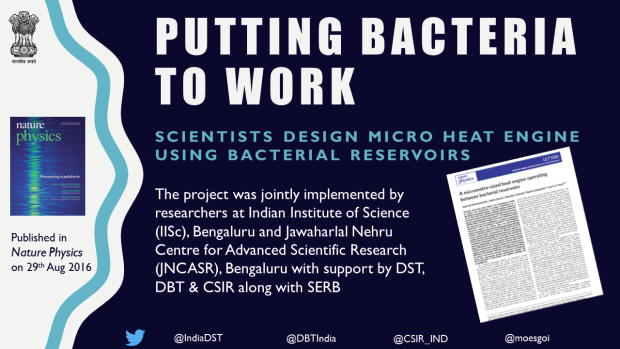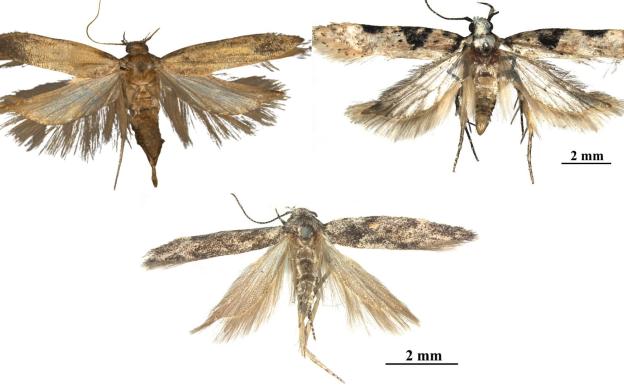
Can the omnipresent bacteria work for us, run our cars, refrigerate our food or fuel our aeroplanes? Yes, say scientists from the Indian Institute of Science and the Jawaharlal Nehru Centre for Advanced Scientific Research (JNCASR), Bangalore. In a ground-breaking interdisciplinary experiment, the team have built a micro heat engine that works using bacterial reservoirs. This study was the result of a collaborative effort between Prof. Ajay Sood and his graduate student Sudheesh Krishnamoorthy from the Department of Physics, IISc, Dr. Rajesh Ganapathy from JNCASR and Prof. Dipankar Chatterji and his student Subho Ghosh from the Molecular Biophysics Unit, IISc.
A heat engine like Stirling or Carnot Engine converts heat energy to mechanical work by taking up heat energy from a hot reservoir, doing work with it, and dumping some heat into a cold reservoir. A “working substance” – usually a fluid or gas, is repeatedly passed between the reservoirs in a periodic process called the engine’s cycle. The expansion/contraction of the gas is then used to push a piston, rotate a wheel and power whatever machine parts the engine is connected to. This seemingly simple principle came into being with the invention of the steam engine and still, a couple hundred years down the line, powers a range of appliances- cars to large scale industrial machines.
The work by Prof. Sood and his team is a first of its kind to extract work without significant temperature difference between the “hot” and “cold” reservoirs. This pioneering work, which uses an ‘active’ reservoir of motile bacteria, was recently published in the journal Nature Physics and could potentially be a key step in understanding the elusive biological motors.
Classical engines use a bulk of gas as the working substance, whereas micro engines use a single particle. Building on previous work, the team has used a 5 micrometer sized colloidal bead held in an ‘optical trap’ of highly focused laser beam as the working substance. Changing intensity of the laser light controls the bead’s motion in the trap, mimicking the action of a piston.
All previous work on heat engines have used passive/thermal reservoirs with negligible fluctuations in temperature. In this study, Prof. Sood and his team brought in the innovative idea of using an “active” reservoir - a suspension of motile bacteria B.Licheniformis - in their micro Stirling engine. “The work was initially motivated by the quest to understand biological engines”, says Prof. Sood. Biological engines act inside living cells which are perfect examples of active reservoirs.
Active reservoirs are, by definition, out of equilibrium, or in simple terms, subject to huge amounts of fluctuations or noise. The disturbance created by the mobility and metabolism of the bacteria in the reservoir is one such source of noise. The colloidal bead, which would do small excursions around the centre of the laser beam when left to itself, is now moved around crazily due to these disturbances.
In a usual thermal/passive reservoir, the bead’s position would follow what is technically termed as a ‘Gaussian profile’ where there is a maximum probability for the bead to remain at the trap centre and large excursions of the bead from its central position are practically very small. Contrary to this, in an active reservoir, there is substantial ‘non-Gaussianity’ in the particle dynamics. Simply put, extreme deviations of the bead from the central position are allowed in the new setup, though rarely. This is the very tenet cleverly exploited by Prof. Sood and his team in their work.
Bacterial activity, being extremely sensitive to the reservoir temperature, is a highly tunable parameter. The cycle executed by the micro engine by periodically modifying bacterial activity and trap laser intensity is analogous to the macroscopic Stirling cycle.
The results of the study pointed that the efficiencyof the bacterial engine was almost an order of magnitude larger than its passive counterpart and was only a factor of two smaller than biological motors. At the highest investigated activities, the work output was equal to that of a passive engine working between reservoirs with such enormous temperature differences as 1800 K, while the actual temperature changes required to manipulate bacterial activity during the active engine cycle remained less than 20K.
The ‘non-Gaussian fluctuations’ in the active reservoir was found to tremendously improve the engine’s efficiency - a hitherto untapped resource. “We have been able to establish that 57% of the total work and 55% of the total efficiency is due to non- Gaussian fluctuations”, explains Prof. Sood about the reason behind the high efficiency.
Although exact mechanisms to couple it to real devices in order to extract useful work remains to be investigated, with an impressive efficiency of almost 50 %, the bacterial engine displays promising potential to power micro and nano electro-mechanical devices in the near future.
This experiment is the first to realise an extremely interesting and fundamental theoretical prediction – extracting work by cyclingbetween reservoirs of identical temperature owing to the differences in noise fluctuations. As Prof. Sood puts it, “the active bacterial engine has fundamental theoretical implications”. The current work will undoubtedly trigger deeper investigations to set up a robust theoretical framework to deal with engines operating out of equilibrium.
Biological engines are known to have very high efficiency, the likes of which man-made engines have been unable to match. Much needs to be learnt about these engines, yet what we do know is that they operate in active reservoirs (living cells) and under constant temperature conditions, just like the bacterial engine discussed here. Hence there is high optimism that the present work may actually be able to shed light on some of these well-kept biological secrets.
About the Research:
The research was funded by the Department of Science and Technology (DST, India), the Department of Biotechnology (DBT, India) and the Council of Scientific and Industrial Research (CSIR) and appeared in Nature Physics as an article titled “A Micrometer-sized Heat Engine Operating Between Bacterial Reservoirs”.






